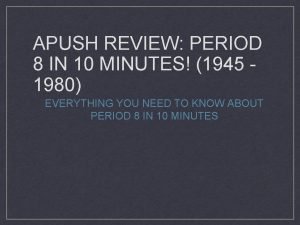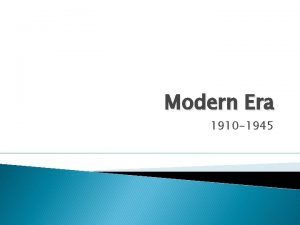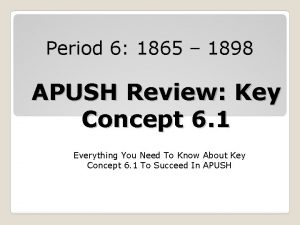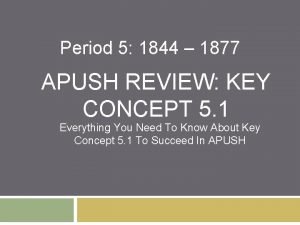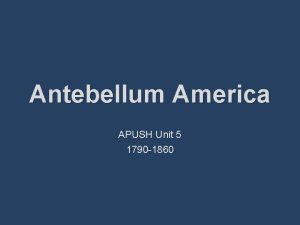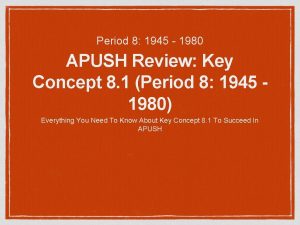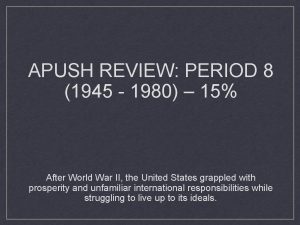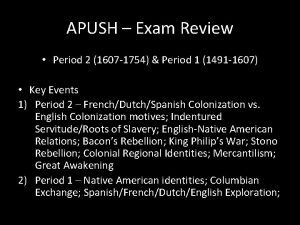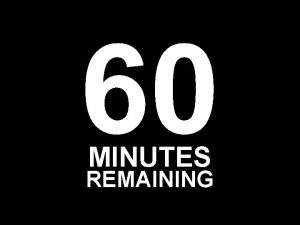APUSH REVIEW PERIOD 8 IN 10 MINUTES 1945












- Slides: 12

APUSH REVIEW: PERIOD 8 IN 10 MINUTES! (1945 1980) EVERYTHING YOU NEED TO KNOW ABOUT PERIOD 8 IN 10 MINUTES

Post-WWII Economy Prosperous economy caused by: Federal spending, baby boom, technological developments Impacts? Improved higher education (G. I. Bill), “Sun Belt” mentioned twice in the curriculum Challenges to conformity by: Artists (Beat Generation - similar to Lost Generation of 1920), Intellectuals (The Affluent Society) and youth

US Foreign Policy Post WWII Containment - George Kennan US sought to keep communism from spreading Seen through: Collective Security - NATO Economic Frameworks - Truman Doctrine, Marshall Plan Conflicts - Korea and Vietnam (North was communist in both) Detente and indirect confrontation SALT vs. Cuban Missile Crisis

US Foreign Policy Post WWII Cold War impact on other countries/regions? US and USSR sought allies among new, decolonized countries (India) Latin America - US supported non-Communist governments, even if they weren’t the most democratic US involvement in the Middle East - oil crises - 1973 oil embargo

Cold War Domestic Issues Both parties supported containing communism, however: Debates emerged over how to root out Communists Mc. Carthyism, Red Scare, HUAC, Rosenbergs, etc. Korean War - some domestic opposition Vietnam War - large, sometimes violent protests - especially post 1968 (Tet Offensive) and 1970 (bombing of Cambodia) Military-Industrial Complex - Eisenhower’s warning about military spending during peacetime Debates about executive branch power (during Vietnam War Gulf of Tonkin Resolution)

Civil Rights Many strategies - legal challenges, direct action, and nonviolent protests All 3 branches of government promoted civil rights: Executive - E. O. 9981 - desegregated military (Truman) Judicial - Brown v. Board Legislative - Civil Rights Act of 1964 White resistance to desegregation: Southern Manifesto, Massive Resistance, Little Rock 9 Debates emerged among activists post 1965: Black power (Black Panthers)

Rights For Other Groups and Other Social Issues Women’s Rights: Betty Friedan’s The Feminine Mystique - challenged the 1950 s “cult of domesticity” Gays and Lesbians: Stonewall Riots: 1969 Latinos: Cesar Chavez - grape pickers’ strike and hunger strike American Indians: Indians of All Tribes (IAT) and American Indian Movement (AIM) - used protests Awareness of Poverty: Michael Harrington’s The Other America - influenced LBJ’s Great Society

Great Society and the Supreme Court Liberalism - using the government to promote social wellbeing Reached its zenith under the Great Society Sought to: End discrimination (Civil Rights Act of ’ 64, V. R. Act of ’ 65) Eliminate poverty - food stamps, Medicaid Fix other social issues - education Supreme Court in the 1960 s - promoted individual freedoms Griswold v. Connecticut - established “Right to Privacy” Helped inspire a conservative movement (more in period 9) People on the left felt liberals did NOT go far enough to change society racially and economically Black Panthers, SDS

Demographics and Counterculture 1950 s image of a nuclear family? 2 children, suburbs, stay at home mom Reality? Women worked more and more as time went on (1970 s) Counterculture - hippies: Challenged their parents’ generation ideals Used drugs and instituted a sexual revolution Debates between conservatives and liberals: Bakke v. University of California: Overturned quotas for minority applicants

Immigration and Environmentalism Immigration Act of 1965: Reversed the quota system from the 1920 s (1921 and 1924) Favored immigration from Asia and Latin America (traditionally underrepresented groups) Rachel Carson’s Silent Spring: Brought awareness to environmental problems Helped lead to the creation of the EPA, Clean Air Act, etc.

Quick Recap Sunbelt Containment Truman Doctrine and Marshall Plan NATO Korea and Vietnam Detente Military-Industrial Complex 3 Branches and Civil Rights Great Society The Feminine Mystique Silent Spring Counterculture Immigration Act of 1965

See You Back Here For Period 9 In 10 Minutes! Thanks for watching! Check out my playlist of 10 minute videos Periods 1 -5 and 6 -9 Review Videos Good luck, you are BRILLIANT!



